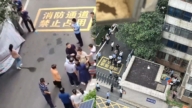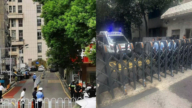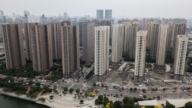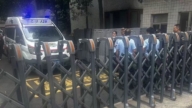【新唐人2011年7月2日讯】连接北京和上海的“京沪高铁”6月30号首次运行。舆论普遍认为,“京沪高铁”于中共建党90周年前夜开通,包含了当局的宣传目地。而体制内专家表示,一般媒体和民众却把目光聚焦在高铁的安全性和高票价、铁道部的贪污腐败以及债务危机上。请看详细内容。
据大陆媒体报导,“京沪高铁”全长1318公里,08年4月开工。2007年的工程概算2209亿元人民币,早已超出三峡工程的投资金额。
而到2020年底,中国大陆高铁线路将扩大到16000公里。铁道部副部长胡亚东日前表示,“京沪高铁”是按照350公里的技术标准建造的。
铁道部原副总工程师周翊民曾全程参与中国高铁的工作。他指出,中国高铁是进口日本和德国的,这些国外高铁公司出售的列车最高运行时速只能是300公里。而铁道部却将试验速度宣传成自己的创新。
上海交通大学土木工程系黄醒春教授解释说,在结构和性能没有变动时就提高速度,是在牺牲安全保障。
而香港理工大学土木工程教授殷建华曾参与京沪高铁监测。他看到,北京到天津的地段中因为人工抽水导致桥墩下沉。
北京交通大学教授赵坚指出,时速300公里的高铁,如果路面沉降超过15毫米,就开不到这个速度。
高铁的安全隐患没有解决,铁道部又在近期传出了贪污腐败,许多人怀疑,贪腐,与高铁的品质和安全之间,有着直接的关系。
目前中国的高铁,主要是今年2月落马的原铁道部长刘志军积极实施的,大陆媒体报导,刘志军在高铁建设中涉嫌贪污8亿元。此外,原铁道部总工程师张曙光已被双规,媒体披露,他在海外有28亿美元存款。
《华尔街日报》曾报导,高铁业内的专家曾对路基所用的水泥强度提出质疑,一位大陆经济学者匿名向海外媒体透露,高铁的工程建设中腐败严重,工程品质不可靠。
由于这些隐忧,大陆铁道部已经被迫减低高铁的运行速度,并暂停修建某些路线。
近年来,世界银行已为中国在轨道设备方面提供了8亿美元贷款。中共当局计划到2015年对高铁投资3500亿元。交通大学教授赵坚警告说,2015年铁道部将面临“债务危机”。
北京交通大学运输经济理论与政策研究所副所长 李红昌表示,高铁如何填补亏损负债,除了自身要发展提高,另一个只能是依赖国家援助。
李红昌:“依靠金融机构的支撑和国家的支助,国家减免债务啊,获这进行补贴,银行展期等等,铁路运营,我们将来还是需要国家经济支助。”
交通大学教授赵坚则认为,铁路是一种大运量输的交通工具,应该面对中低收入的群体。现在面对小众并且还需要国家大量补贴。他分析,从2007年底已经批准的项目中看,铁道部的债务为1.2万亿,而铁道部自身的资产不足一万亿。这样的金融风险是无法偿还的。
不少中国老百姓也对高铁的高票价感到不满。京沪高铁的最低票价接近600元。27号,一位京沪高铁试乘者表示,高铁更适合出差的商务人员乘坐。
北京交通大学运输经济理论与政策研究所副所长李红昌:“铁路的属性一个方面是具有企业性,另外一个方面具有公益性,那么这是一个如何统筹的,如何平衡的问题,不能因为高速列车的发展,就否定大部分老百姓对普通的列车的需求。”
大陆的高铁问题,突显了经济成长策略的缺陷。有报导评论说,昂贵的高铁票价不仅加深中国的贫富差距,并且让未来几年整体预算吃紧。经济学家认为,大陆将因此更依赖以国内投资来提高GDP,这样会延迟对国内的消费和服务业的经济转型目标。
新唐人记者赵心知、王明宇采访报导。
The Four “Highs” of China’s High-Speed Rail
On June 30, the Beijing-Shanghai high speed rail
began its operations.
Media generally believe that it was propaganda that
the high speed rail went into operation on the eve of
Chinese Communist Party’s (CCP) 90th anniversary.
However, the public only focus on the high-speed rail’s
high safety risk and high ticket price issues,
corruption-ridden Railway Ministry and its debt crisis.
Let’s take a look at the report.
As per the media, the construction of the 1318-km
Beijing-Shanghai high-speed rail began in April 2008.
As of 2007, its budget was RMB 221 billion,
exceeding the budget of the Three Gorges Dam project.
By the end of 2020, China’s high-speed rail will
have expanded to a total of 16,000 km.
Hu Yadong, deputy minister of Railway Ministry said,
the trains on this railway could reach 350 km/h.
Zhou Yimin, ex-chief engineer of Ministry of Railways
said, China’s high-speed rail system was imported
from Japan and Germany.
Their bullet trains’ maximum speed is 300 km/h,
but the Ministry used the test speed of 350 km/h
to claim the railway as its own innovation.
Huang Xingchun, professor of civil engineering at
Shanghai Jiaotong University explained, it sacrifices
safety to increase speed without structural changes.
Yin Jianhua, professor of civil engineering at
Hong Kong Polytechnic University, participated in
a monitoring project of the railway. He said that
he witnessed pier sinking during the construction.
Beijing University’s professor Zhao Jian pointed out,
for a 300 km/h railway, if sinking exceeds 15 mm,
it is impossible for the train to reach this speed.
Besides safety issues, corruption issues also surfaced.
Many people believe that corruption is closely related
to the quality and safety of the high-speed railway.
China’s high-speed rail was built under the direction
of ex-Minister Liu Zhijun who reportedly embezzled
RMB 800 million from the high-speed railway project.
Ex-chief engineer Zhou Shuguang is under investigation.
He reportedly possesses USD2.8 billion overseas.
Wall Street Journal once reported that some experts
questioned the quality of cement used in the roadbed.
An anonymous economist in China told overseas media,
severe corruption existed during the construction and
the quality of the project is not reliable.
For these reasons, the authorities have ordered to
run the bullet trains at a lower speed and temporarily
suspended the construction of some parts in the project.
World Bank has provided USD800 million loans
to China for constructing the high-speed railway.
By 2015, the investment will have reached RMB 350 bn.
Professor Zhao Jian warned that the Ministry of Railways
would run into a “debt crisis” in 2015.
Beijing Jiaotong University associate director
Li Hongchang said, besides its own development,
the high-speed railways can only rely on state support
to pay its debts.
Li Hongchang: It will reply on the financial support
of the government to reduce its debts,
such as official subsidies, bank loan extensions, etc.
This is something it will need to do in the future.
Professor Zhao Jian said, railways aiming at volume
transportation should target at middle/low classes,
rather than the small group of wealthy people.
It already requires a huge subsidy from the state.
He said, as per the 2007 data, the Ministry of Railways
owed a debt of RMB 1.2 trillion, but its own assets
were less than this amount. The financial risk is too high.
Many Chinese people are discontent about
the high ticket prices of the high-speed rail.
The lowest ticket price from Beijing to Shanghai is
almost RMB 600. On June 27, a passenger said
the high-speed rail is more suitable for businesspeople.
Li Hongchang: Railways should be suitable to
both enterprises and public services.
It requires a balance between the two.
High-speed rail development should not disregard
the needs of the majority of ordinary folks.
China’s high-speed rail problem accentuates
a defect in the policy for economic development.
Some comments said, the high prices will widen
the wealth gap and tighten the budget in China .
Economists believe, China will reply more on internal
investments to boost the GDP, which will delay
the economic transition of domestic consumption
and service sectors.
NTD reporters Zhao Xinzhi and Wang Mingyu




























